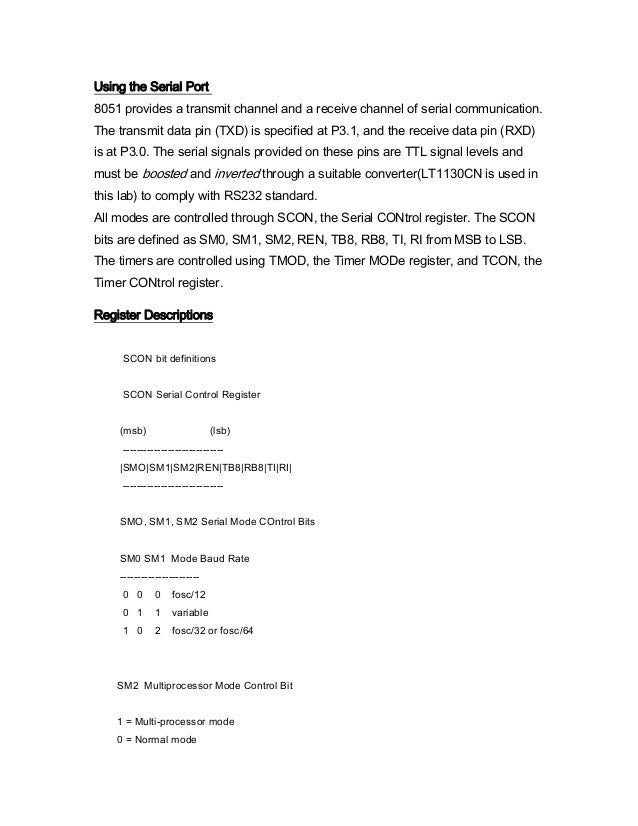Serial Port Interfacing In C Language
ORIGINAL: leenzz my project's name is Design and Implementation of Parallel Port-Based Data acquisition system. Who gave it this name? Download Corsicana Lemonade Rarest. Did they have any idea of the implications? If this is the way you have to go, then you need to learn more about the PC parallel port. Most can operate in multiple modes. In 'standard' mode, the data lines are output only, so you have to use the five status lines to manipulate data into the PC.
Possible, but messy. In 'Bidirectional mode (aka 'PS/2 mode'), you can flip a bit in the control register to make the data lines inputs. I'm not sure how many LPT ports support that these days. In EPP mode, you can do reads and writes over the data lines.

Blinking of led using c using parallel port. Port is easier and faster than programming the serial port. Parallel Port Interfacing using Assembly Language. Languages for serial port interfacing. But i'm new to this and i'd like to know which programming language to use to easily achieve this: VB, VB.net, C++.
The control signals all change their use slightly. Cost To Replace Sash Windows. In ECP mode, you can also do reads and writes over the data lines, but the procedure is quite different to EPP. Your first task is to research these modes, and decide which is most suitable for your project. Now, what language are you going to use on the PC? Accessing the parallel port registers directly isn't as straightforward as ti is for the serial port.
Your '877 chip has a built in serial port. However, if you want to interface with a PC you will have to add a MAX232 chip to the Rx and Tx I/O pins. You can replace the MAX232 with some glue logic. But, I find the results can get tricky sometimes. The quick-and-dirty tried-and-tested way is to use the MAX232. Most people do not realize that ALL PC parallel ports have enough I/O pins to output 8-bit data and input 8-bit data (with the addition of one glue-logic IC), with an additional 5-I/O pins for data control.

For several years, a company marketed a cable that connected between two computer's Parallel Ports. I was used for data transfer.
It was a lot faster than the serial link alternitive. It is 10 times faster than the serial port. The port's fuctions were enhanced by making the eight output pins bidirectional. That leaves more I/O pins for multiplexing. And, IBM in the orginal specs had a great idea. It said the 64 port addresses beginning at 300h can not be uses by any slot cards. They left the addresses for proto-type development.
So, if you want to construct your own slot card project, you are not tied to using a printer-port card. Most printer port slot cards can be 'fixed' to use the 300h window. That means your projects will never clash with anything else running on your PC. Accessing the parallel port is far easier than the serial port.
Every language has instructions for 'poking and peeking' the port addresses. Though Microsoft's C makes it a little harder. The parallel port can bring uniformity to your projects. Every pin of the Centronics Parallel Printer Port, and the IBM inproved DB-25 printer port, all use the same pin assignments. Each pin has a name, fuction, and polarity, which does not change from company to company.
Though it may not be cost effective to tie up your blown tower's printer port for interface to your PIC, It still has some valid uses. I often us an old laptop or XT for robotic control. And many single board computer have a parallel port. Just look at Advantech's boards. Stepping motors run rather slow.
So, using an old XT, running Quick Basic under DOS, is very efficient. Your project is a 'no brainer' for the printer port. As for where to get parallel port information: Get a copy of the book 'Controlling The World With Your PC' By Paul Bergsman, HighText (one work) Pub. If you have a problem finding the book, (it's been in publication for over 12 years, and the market for parallel port projects is shrinking), then send me an email at:. I still have a supply and willl send you an autographed copy for a discount price. If you have DOS, you have Quick Basic. And, Turbo Pascal for DOS also includes everything you need to access the printer port.
Using anything else is overkill for the project he wants to do. My book includes code listings in QBasic, and Pascal, for almoat every application (about 50). The external interrupt, and the R/C survo motor, applications required assembly language. When Microsoft introduced Windows, they were targeting big business. They don't care about the individual working in his home.
The big money is in a large network running in a large office building. Every computer needs an operating sustem. And Microsoft checks that big business pays for each and every operating system on every computer in the work place. Microsoft did not want programmers messing with the ports on the network. So, Visual Basic has no instructions for port control.